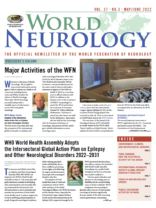Webinar by the Environmental Neurology Specialty Group (ENSG).
By Safa Younis and Mohammad Wasay

Safa Younis and Mohammad Wasay
In honor of World Environment Day celebrated annually on June 5, the World Federation of Neurology (WFN) hosted a webinar to raise awareness and explore the relationship between environmental factors and the brain. This webinar unpacked variables such as climate change and chemical pollutants as risk factors for neurological disorders.
Esteemed neurologists from around the world spoke at this event, including Dr. Mohammad Wasay, who moderated the webinar, Dr. Wolfgang Grisold (WFN president), Dr. Gustavo Roman (ENSG president), Dr. Jacques Reis, Dr. Anna Ranta, Dr. Peter Spencer, Dr. Philip Landrigan, Dr. Serefenur Ozturk, Dr. Augustina Charway Felli, Dr. Hidehiro Mizusawa, Dr. Teresa Corona, and Dr. Alla Guekht.
Of the many themes discussed, Dr. Reis elaborated on environmental challenges that society faces and the neurologists’ role as the climate changes. He specifically examined the correlation between climate change and an increase in neurological diseases. He said that according to the World Economic Forum Davos: The Global Risks Report 2022 — climate action failure, extreme weather events, and biodiversity losses will likely be the most concerning global risks over the next decade. Further, Dr. Anna Ranta conferred the benefits of green spaces on vascular brain health. There is evidence that exposure to green spaces has a positive impact on stroke prevention, severity, and mortality. Dr. Peter Spencer discussed the climate-relevant neurotoxic botanicals linked with human motor-neuron diseases such as Lathyrus sativus, Cycas micronesica, Manihot esculenta, and Gyromitra esculenta. He demonstrated that these botanicals can be linked to certain neurological diseases such as Lathyrism, Cassavism, and Amyotrophic Lateral Sclerosis-Parkinsonism-Dementia Complex.
Dr. Philip Landrigan spoke about climate change, chemical pollution and the developing human brain. There is growing evidence that toxic chemicals can cause neurodevelopmental disorders in children, since they are more sensitive to chemicals in the environment compared to adults. Dr. Landrigan also expressed that there may be countless unrecognized chemicals causing neurotoxicity in children. He stated a great example of how lead was removed from gasoline, which was known to cause neurotoxicity. The benefits for this action included a 2- to 5-point gain in population mean IQ and a $200 billion annual economic benefit to the U.S. through increased economic productivity of more intelligent and creative children, simply by removing one neurotoxic chemical from the environment. Dr. Gustavo Roman shared lessons learned from COVID-19 from an environmental point of view.
Dr. Wolfgang Grisold concluded the program by emphasizing the importance of this discussion in our everyday lives. This enlightening webinar encourages future research that assesses the correlation between environmental factors and neurological conditions.
Dr. Serefnur Ozturk (ENSG vice president) emphasized policy changes to improve air pollution and brain health. Dr. Augustina Charway (African Academy of Neurology president) discussed brain health challenges in Africa. •
Mohammad Wasay is Alicharan Endowed Professor of Neurology, Department of Medicine, Aga
Khan University, Karachi, and Secretary General, Environmental Neurology Specialty group, WFN.
